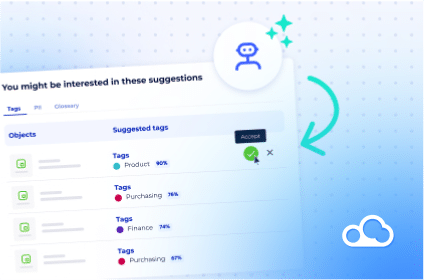As businesses look beyond the boundaries of a single cloud provider, multi-cloud data management provides a new approach: Distributing data assets across multiple cloud environments.
Mastering multi-cloud data management is especially important as tools like data catalogs and metadata management platforms are increasingly integrated into the equation to ensure data consistency and accessibility.
Understanding multi-cloud environments
Multi-cloud data management shares data assets across many cloud environments to optimize performance, enhance resilience, and capitalize on specific cloud offerings. At its core, a multi-cloud environment represents a conscious business strategy to diversify and optimize cloud resources. Rather than anchoring an enterprise’s operations and data to a singular cloud provider, a multi-cloud approach actively seeks out the offerings from multiple cloud services. But why is this diversification essential?
First, multi-cloud data management offers an escape from the constraints of vendor lock-ins, allowing businesses greater flexibility in their operational choices. This translates to improved scalability, as different cloud providers excel in various niches, be it computational power, storage solutions, or specialized services.
Another pivotal driver of the multi-cloud adoption wave is risk distribution. By decentralizing data and processes across different cloud platforms, enterprises diminish the impact of any singular cloud platform’s potential downtime or failure. This ensures enhanced fault tolerance, safeguarding business operations from unexpected disruptions.
The core principles of multi-cloud data management
Throughout the process of managing data across multiple cloud platforms, adhering to certain core principles becomes the bedrock of success. One cannot merely scatter data across clouds and hope for efficient operations.
Instead, an orchestrated strategy that includes data consistency and security is paramount for data governance success. In a multi-cloud setup, security cannot be an afterthought. With data dispersed across various platforms, each with its own security protocols, a unified security strategy becomes essential. This not only involves deploying advanced encryption techniques but also maintaining consistent access controls across the board.
The multi-cloud approach also warrants a watchful eye on costs: With each cloud provider having its pricing model, businesses must be adept at monitoring and optimizing costs to avoid unexpected financial pitfalls.
The vital role of a data catalog
In the vast and intricate tapestry of multi-cloud infrastructure, a data catalog emerges as a key instrument, orchestrating harmony amidst potential chaos. This is more than just a mere directory or a reference tool; it is the sentinel of order in an environment brimming with diverse datasets scattered across different cloud platforms. A data catalog serves as the nexus that bridges the myriad data islands, ensuring a coherent, unified view of an enterprise’s dispersed data assets.
Data catalogs work diligently to index every piece of data, annotate it with rich metadata, and provide a streamlined interface for users to understand and access the data they require. This understanding is crucial in a multi-cloud setup where knowing the ‘what’, ‘where’, and ‘how’ of data becomes the foundation of efficient operations.
Beyond its primary role, the data catalog is also the gatekeeper of data quality. By keeping track of data lineage and usage patterns, it ensures that reference data remains pristine and up-to-date. It becomes the touchpoint for data stewards, analysts, and business users, enabling them to collaborate, share insights, and drive data-driven initiatives with clarity and confidence.
The significance of metadata management tools
Metadata, data about data, holds the secret to navigating the expansive seas of a multi-cloud environment. Metadata management tools serve as a compass to illuminate data’s path and ensure that every data journey reaches its intended destination.
By meticulously organizing and interpreting metadata, these tools provide an intricate map of the data landscape and reveal the relationships between datasets, highlight data provenance, and offer insights into how data has been used and transformed over time. In the complex web of multi-cloud data management, such insights are invaluable because they not only ensure data accuracy and integrity, but they also empower businesses to derive meaningful insights and build trust in their data-driven endeavors.
Furthermore, a metadata management tool fosters collaboration. As team members from diverse departments embark on their individual data quests, these tools ensure they’re aligned, basing their decisions on consistent and trusted data.
Addressing data security & compliance
One of the challenges in multi-cloud data management is ensuring consistent data security and regulatory compliance across various cloud platforms. It involves harmonizing security protocols, access controls, and encryption mechanisms to ensure that data remains protected irrespective of its location. Additionally, staying compliant with regional data regulations necessitates a thorough understanding of data residency and sovereignty issues.
Cost optimization in multi-cloud setups
Operating in a multi-cloud environment offers flexibility, but also brings forth the challenge of managing costs. Efficient multi-cloud data management involves analyzing the cost structures of each cloud provider, identifying data transfer costs, and leveraging tools that provide insights into resource consumption. By understanding and optimizing these costs, enterprises can ensure financial efficiency without compromising on performance.
Ensuring data mobility & accessibility
In a multi-cloud environment, data mobility becomes crucial. Organizations must ensure that data can seamlessly move between different cloud platforms without incurring bottlenecks or inconsistencies. This involves employing data integration tools, setting up data pipelines, and ensuring that data formats remain consistent across the board.
The future of multi-cloud data management
As the cloud ecosystem evolves, so will the nuances of multi-cloud data management. Businesses will increasingly look towards automation, artificial intelligence, and machine learning to streamline data operations across multiple clouds. Moreover, with the continuous development of tools and platforms, managing data in a multi-cloud setup will become more intuitive, ensuring that businesses can harness their data assets effectively, irrespective of where they reside.
Conclusion
Multi-cloud data management is dynamic, necessitating a blend of strategy, technology, and foresight. As enterprises delve deeper into the multi-cloud world, tools like data catalogs and metadata management tools will play an ever-increasing role in ensuring that data remains a consistent, accessible, and valuable asset.
—
Learn even more about using your data as an asset to achieve higher levels of data governance and data quality. Book a demo today to get started on your organization’s journey to complete data lifecycle management with DataGalaxy!





